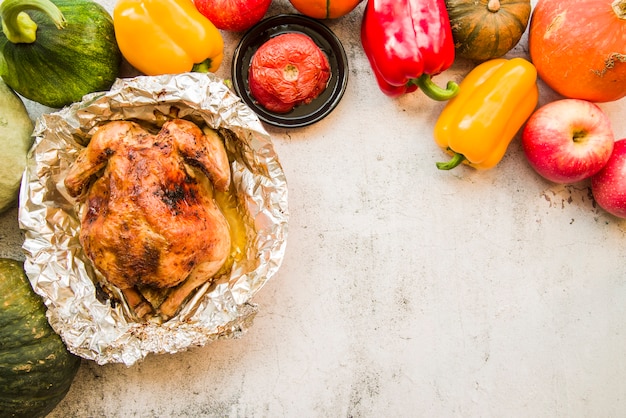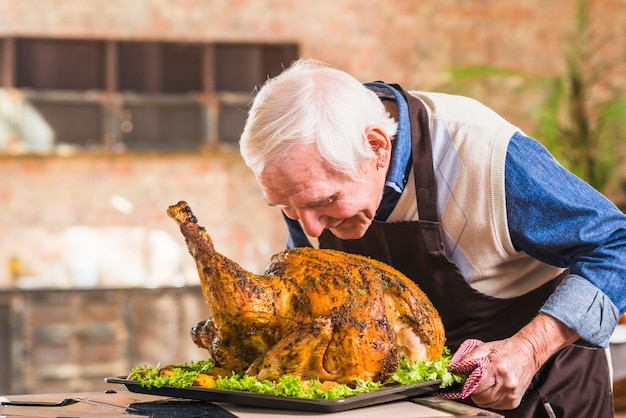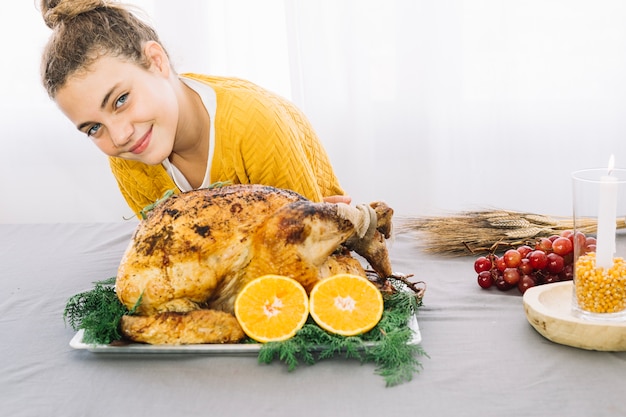This Christmas, I set my sights on a culinary challenge – roasting a 21-pound turkey. Now, I’m not claiming to be a Michelin-star chef, but I hold my own in the kitchen. I’ve roasted turkeys before, but nothing this colossal! It felt like wrestling a small, feathered dinosaur. I knew I was in for a wild ride, but I love a good challenge, especially when it involves a delicious, roasted bird.
What I didn't realize is just how much planning and preparation goes into roasting a turkey of this size. It's not just about throwing it in the oven and hoping for the best. You need to be strategic, ensuring the bird is cooked perfectly – tender and juicy inside, with a golden-brown, crispy skin. And no one wants a dry, overcooked turkey – that's a recipe for holiday disappointment!
(Part 1) Choosing the Right Bird: A Turkey Tale

The first step, of course, is selecting the right turkey. Don’t just grab the first one you see! You need to be a bit of a turkey connoisseur. Look for a bird that's plump and well-fed, with skin that has a healthy, even color. It should feel firm to the touch, and you definitely want to avoid any turkeys with a strong, off-putting odour or slimy skin. Trust me, you don't want to risk that!
Key Turkey Selection Tips
- Plump and Well-Fed: A well-fed turkey will have a nice, plump breast and thighs. It should feel heavy for its size, like it's been living the good life!
- Good Skin Colour: The skin should be a nice, healthy color, not discolored or bruised. This indicates freshness.
- Firm to the Touch: A firm turkey is a good sign of freshness. If it feels squishy or wobbly, it's probably not the best choice.
- No Strong Odour: If the turkey has a strong odour, it's likely not fresh. Go for a bird that smells clean and fresh.
- No Slimy Skin: The skin should be dry, not slimy or wet. If it's slimy, it's probably not fresh and could be a sign of spoilage.
I headed to my local butcher shop, and let me tell you, they know their turkeys. The butcher was incredibly helpful, guiding me toward the perfect bird and offering valuable tips for cooking it. He even emphasized the importance of a turkey with a good amount of fat, which helps keep it moist during cooking. He also recommended brining the turkey, a technique I was eager to try.
(Part 2) Brining the Turkey: A Salty Soak

brining a turkey is a game-changer. It significantly improves the flavor and tenderness of the meat. It's a simple process, but it can be a bit of a hassle, especially with a 21-pound bird. You need a large container, and the turkey needs to soak in the brine for several hours. But believe me, the effort is worth it. It's like giving your turkey a luxurious spa treatment before the big day!
Brining Recipe: A Simple Salt Solution
Here's the recipe I used, and it’s super simple:
- 1 gallon of cold water (about 4 liters)
- 1 cup kosher salt
- 1/2 cup brown sugar
- 1/4 cup black peppercorns
- 1/4 cup bay leaves
- 1 lemon, sliced
Combine all the ingredients in a large container, making sure the turkey is fully submerged in the brine. Cover the container and refrigerate for 12-24 hours. Once the brining is complete, remove the turkey from the brine and pat it dry with paper towels.
(Part 3) Preparing the Turkey: Getting Ready for the Roast

Now that the turkey has been brined, it's time to get ready for roasting. This involves removing the giblets and neck from the turkey's cavity. I know, it sounds messy, but it's a necessary step. These giblets can be used to make a delicious gravy or stuffing. I personally used mine to create a rich, flavorful gravy that everyone raved about.
Preparing a Turkey for Roasting: Step-by-Step
- Remove the Giblets and Neck: Cut open the cavity of the turkey and carefully remove the giblets and neck. These are usually tucked away in a small bag inside the cavity. You can save them for gravy or stuffing later.
- Pat the Turkey Dry: Once the giblets and neck are removed, pat the turkey dry with paper towels. This will help ensure that the skin crisps up nicely during roasting.
- Season the Turkey: Generously season the turkey with salt, pepper, and any other herbs or spices you like. I used a combination of rosemary, thyme, and sage, which gave it a delightful savory flavor. I also slipped a few lemon slices under the skin for a subtle citrus tang.
- Stuff the Turkey (Optional): You can stuff the turkey with your favorite stuffing, but this is not necessary. With a 21-pound turkey, there's plenty of meat to go around! I decided to skip the stuffing and just roast the turkey on its own, but if you prefer stuffing, make sure it's cooked to an internal temperature of 165°F (74°C).
(Part 4) Roasting the Turkey: The Heart of the Feast
Now comes the moment of truth. Your turkey is prepped and ready to go, so preheat that oven. You'll need a large roasting pan, and I highly recommend using a roasting rack. This will allow air to circulate around the turkey, ensuring even cooking. This is especially important with a larger bird like yours.
roasting time and Temperature: Finding the Right Balance
One of the most important things to remember when roasting a turkey is to use the correct temperature and cooking time. The general rule of thumb is to roast a turkey at 325°F (165°C) for about 13-15 minutes per pound. However, this can vary depending on the size of the turkey and your oven. For my 21-pound turkey, I roasted it for approximately 4 hours.
I used an oven thermometer to ensure the oven was at the right temperature. It's also a good idea to use a meat thermometer to check the internal temperature of the turkey. The turkey is done when the internal temperature reaches 165°F (74°C) in the thickest part of the thigh. I also checked the internal temperature of the breast, and it was well above 165°F.
Turkey roasting tips: Secrets to Success
- Use a Roasting Rack: As mentioned earlier, a roasting rack promotes even cooking and allows for crispy skin.
- Baste the Turkey: Basting the turkey with pan juices or butter will help keep it moist. I basted my turkey every 30 minutes or so. It’s a bit of work, but the results are worth it!
- Rest the Turkey: Once the turkey is cooked, let it rest for at least 15 minutes before carving. This allows the juices to redistribute throughout the meat, resulting in a more tender and juicy turkey. It's a little bit of patience that pays off big time.
(Part 5) Carving the Turkey: A Masterful Display
Carving a 21-pound turkey is a bit of a production, let me tell you! You'll need a sharp carving knife, a large cutting board, and maybe a bit of extra muscle. I even used a meat cleaver to help cut through the thickest parts of the turkey. But hey, don't be afraid to ask for help if you need it!
Carving Tips: Slice and Dice with Confidence
- Use a Sharp Carving Knife: A sharp knife makes carving easier and prevents tearing the meat. It's a good investment for any cook!
- Carve the Breast First: Start by carving the breast into slices. You can either carve the breast in one piece or cut it into smaller pieces, depending on your preference.
- Remove the Legs and Thighs: Once the breast is carved, remove the legs and thighs. You can then carve the legs and thighs into smaller pieces. Don't forget to save the drumsticks for those lucky guests!
- Carve the Wings: The wings can be carved into smaller pieces or left whole, depending on how you plan to serve them.
After carving the turkey, I arranged the slices on a platter, garnished it with parsley, and admired my culinary creation. It looked beautiful and smelled absolutely divine, ready to tempt my guests.
(Part 6) Making Gravy: A Rich and Flavorful Sauce
No Christmas dinner is complete without a delicious gravy. I used the turkey drippings and the giblets I saved to make a rich and flavorful gravy. It’s like magic, transforming those drippings into a culinary masterpiece!
Gravy Recipe: A Simple and Delicious Sauce
- 1/2 cup turkey drippings
- 1/4 cup all-purpose flour
- 4 cups chicken broth
- Salt and pepper to taste
- 1/2 teaspoon dried thyme
- 1/4 teaspoon dried rosemary
- 1/4 cup chopped giblets (optional)
In a saucepan, whisk together the turkey drippings and flour until smooth. Slowly whisk in the chicken broth until the gravy is smooth and thickened. Season with salt, pepper, thyme, and rosemary. Simmer for 5-10 minutes, or until the gravy has thickened. Stir in the giblets, if using.
I served the gravy in a gravy boat and poured it over the turkey and mashed potatoes. It was the perfect complement to the turkey, adding a touch of richness and depth of flavor.
(Part 7) side dishes: The Perfect Accompaniments
Now, you're probably wondering what side dishes go well with a roast turkey. You need something to soak up all that delicious gravy, right? I went with a classic combination of mashed potatoes, gravy, stuffing, cranberry sauce, and green beans. I also made a delicious sweet potato casserole with a pecan crumble topping. Let's just say, there was no shortage of food at my Christmas dinner. It was a feast for the senses!
Side Dish Ideas: A Culinary Symphony
- Mashed Potatoes: A classic side dish for roast turkey, mashed potatoes are simple to make and go well with the turkey's savory flavor. They're a comforting and satisfying addition to any holiday meal.
- Stuffing: Stuffing is another classic side dish that's always a hit. There are endless variations of stuffing, so you can find one that suits your taste. It's a perfect way to showcase your culinary creativity.
- Cranberry Sauce: Cranberry sauce adds a touch of sweetness and tartness to the meal. It's a classic side dish that's sure to please everyone. It provides a nice contrast to the savory turkey and other dishes.
- Green Beans: Green beans are a simple and healthy side dish. You can steam them, roast them, or sauté them. They add a touch of freshness and vibrant color to the table.
- sweet potato casserole: A sweet potato casserole is a delicious and comforting side dish. It's a great way to use up leftover sweet potatoes and brings a touch of sweetness to the meal.
(Part 8) Dessert: The Sweet Finish
After all that delicious food, you might think, “I could never eat dessert.” But trust me, there’s always room for dessert, especially when it’s Christmas! I made a classic pumpkin pie with a flaky crust. It was the perfect ending to a perfect Christmas meal, a sweet and satisfying way to conclude the celebration.
Dessert Ideas: A Sweet Ending to a Feast
- Pumpkin Pie: A pumpkin pie is a classic dessert that's perfect for the holidays. It's made with pumpkin puree, spices, and a flaky crust. It's a comforting and festive dessert that everyone enjoys.
- Apple Pie: An apple pie is another classic dessert that's always a crowd-pleaser. It's made with apples, sugar, cinnamon, and a flaky crust. It's a warm and comforting dessert that brings back memories of home.
- Chocolate Cake: A chocolate cake is a rich and decadent dessert that’s sure to satisfy your sweet tooth. It’s a great way to end a special meal. It's a classic choice for a special occasion like Christmas.
(Part 9) Leftovers: A Culinary Treasure Trove
The best part of roasting a turkey? The leftovers! Who doesn’t love a turkey sandwich? You can also use the leftover turkey to make a variety of other dishes, like turkey soup or turkey pot pie. Don't forget to save some of the gravy, too! I even made a delicious turkey noodle soup with the leftover carcass. I had enough leftovers to last me for days! It's like a culinary gift that keeps on giving.
Leftover Turkey Ideas: Creative culinary adventures
- turkey sandwiches: Turkey sandwiches are a classic way to use leftover turkey. You can make them with bread, rolls, or wraps. They're perfect for a quick and easy lunch or snack.
- Turkey Soup: Turkey soup is a delicious and comforting way to use leftover turkey. You can make it with vegetables, noodles, or rice. It’s a warm and comforting meal, perfect for a chilly day.
- Turkey Pot Pie: A turkey pot pie is a hearty and satisfying way to use leftover turkey. It's a great meal for a cold winter day. It's a perfect way to showcase the versatility of turkey.
(Part 10) Tips for a Successful Turkey Roast: Essential Strategies
Here are a few tips that I learned from my experience roasting a 21-pound turkey: These are tips that have helped me create memorable and delicious turkey roasts, and I hope they help you as well.
- Plan Ahead: Roasting a turkey takes time, so it’s important to plan ahead. Make sure you have all the ingredients and supplies you need before you start cooking. Don't wait until the last minute! It’s a great idea to create a detailed timeline for the entire process.
- Use a Meat Thermometer: A meat thermometer is essential for ensuring that the turkey is cooked through. It's also a great way to check the internal temperature of the stuffing, if you're using it. Don't rely on visual cues alone, use a thermometer to ensure safety and perfect results.
- Don’t Overcook the Turkey: Overcooked turkey is dry and tough. Make sure to cook the turkey to the correct internal temperature and no longer. Overcooked turkey is a culinary tragedy! Use the meat thermometer as your guide.
- Let the Turkey Rest: Letting the turkey rest for at least 15 minutes before carving will allow the juices to redistribute throughout the meat, resulting in a more tender and juicy turkey. Patience is key here! It's a small step that makes a big difference.
FAQs: Your turkey roasting Questions Answered
I know you might have some questions about roasting a turkey, so here are some FAQs: These are questions I've been asked many times over the years, and I'm happy to provide you with the answers you need for a successful turkey roast.
1. How long should I roast a 21-pound turkey?
You should roast a 21-pound turkey for about 4 hours at 325°F (165°C). However, this can vary depending on your oven and the size of the turkey. Always use a meat thermometer to check the internal temperature of the turkey. Don’t be afraid to adjust the cooking time based on your oven and the turkey's size.
2. Should I stuff the turkey before roasting?
You can stuff the turkey, but it’s not necessary. If you do stuff the turkey, make sure the stuffing is cooked to an internal temperature of 165°F (74°C). If you're stuffing the turkey, ensure the stuffing is cooked thoroughly. You can also stuff the turkey after roasting, which eliminates the risk of undercooked stuffing.
3. How do I know if the turkey is cooked through?
The turkey is cooked through when the internal temperature reaches 165°F (74°C) in the thickest part of the thigh. You can use a meat thermometer to check the internal temperature. Don't rely on just looking at the turkey - use a thermometer for accuracy.
4. What should I do if the turkey is dry?
If the turkey is dry, you can try to add some moisture back in by basting it with pan juices or butter. You can also add a little bit of broth to the turkey pan. Basting and adding broth can help make a dry turkey more juicy and flavorful.
5. How do I store leftover turkey?
Leftover turkey should be stored in the refrigerator for up to 3-4 days. You can also freeze leftover turkey for up to 2-3 months. To freeze turkey, wrap it tightly in plastic wrap and aluminum foil. Proper storage ensures that your leftovers stay safe and flavorful for a longer period.
Everyone is watching

Corn on the Cob: The Ultimate Guide to Perfectly Cooked Ears
Healthy MealsAh, corn on the cob. Just the name evokes images of sunny days, barbecues, and that sweet, juicy flavour that ...

Perfect Pork Roast Oven Cooking Time: A Guide to Delicious Results
Healthy MealsThere's something truly satisfying about a perfectly roasted pork. The aroma alone is enough to make your mout...

Ham Cooking Time: How Long to Bake, Smoke, or Boil a Delicious Ham
Healthy MealsAh, ham. It's a classic, isn't it? A real crowd-pleaser, especially around holidays. And when done right, it'...

Scallops: The Ultimate Guide to Perfect Cooking
Healthy MealsAh, scallops. Those delicate, sweet, and utterly delicious morsels of the sea. They hold a special place in my...

Spaghetti Squash: The Ultimate Guide to Cooking and Serving
Healthy MealsRemember that time you saw spaghetti squash at the supermarket, looking all bumpy and strange, and thought, "W...
